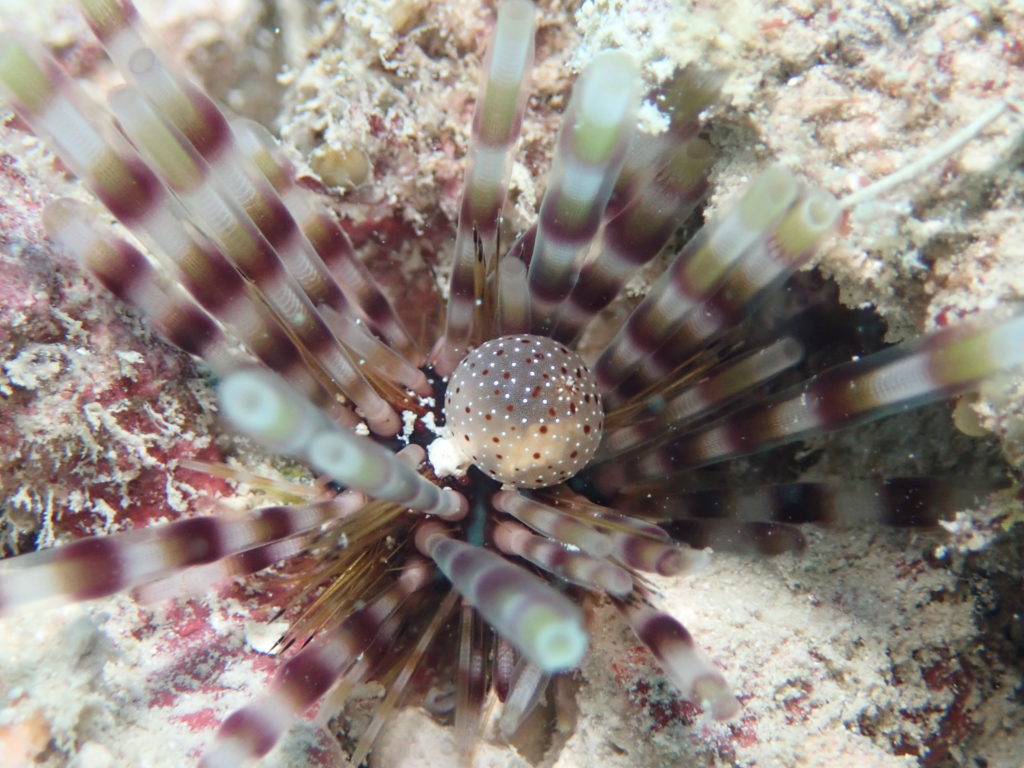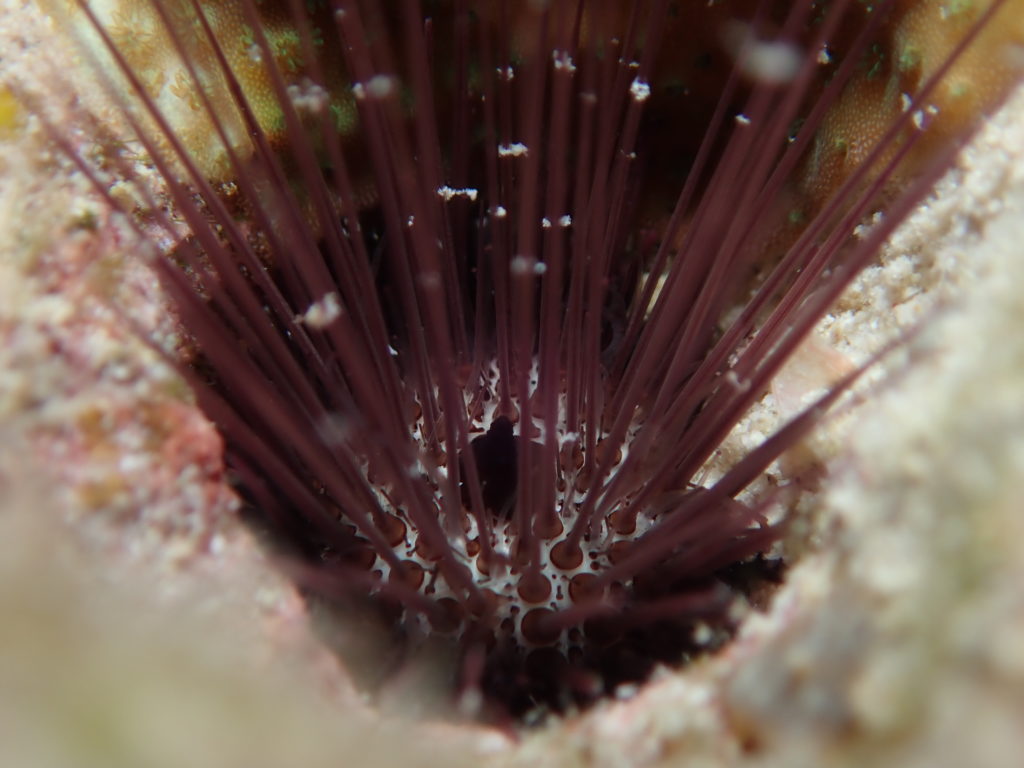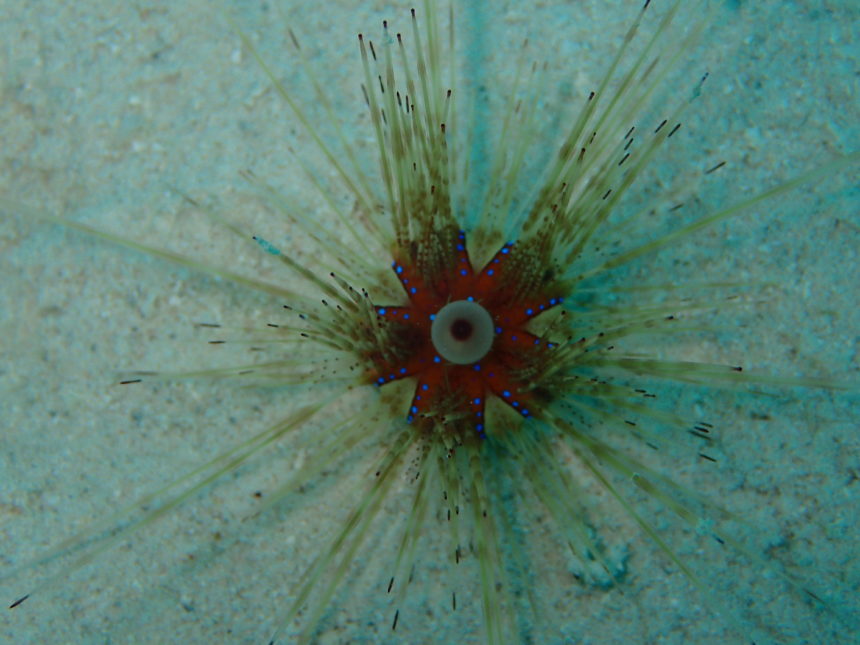Those of us who are actively doing marine conservation underwater are no stranger to this spiny, round animal known as sea urchins.
Sea urchins are classified as Phylum echinodermata and they are close relatives of starfish and sea cucumber. They can be found everywhere in the depth zones of the ocean, from intertidal to 5,000 meters. We often encounter them on the seabed, hiding in between corals or in large groups near dead corals.
It is believed that they have lived in the sea since hundreds of millions years ago and there are at least 950 species of sea urchins with sizes ranging from 3cm to the 36cm. In Bawah Island the one we’ve managed to identify so far is Diadema setosum (long-spined sea urchin), a common species found throughout the Indo-Pacific region.
Sea urchins have unique anatomy
Sea urchins are covered by rigid exoskeletons made from calcium carbonate, also known as chalk. The spines on their body are divided into two categories: primary for longer spines, and secondary for shorter ones.
Scattered among their spines are holes for tentacle-like objects called tube feet. The feet on the underside part of their body are for walking while the rest are for other tasks like attaching themselves onto a surface or to flip themselves when they get turned over. These tube feet are also light-sensitive and perform as sea urchin’s eyes.

They help protect coral reefs
Sea urchins are great allies for our coral conservation program since they feed primarily on algae. Overabundance of algae are threats to corals because they take up space where corals can live and they also grow on corals, preventing the latter from getting enough sunlight for photosynthesis process.
On the other hand, sea urchins population should also be kept under control as certain algae are actually beneficial for coral reefs like coralline algae that help the formation of new coral.
Careful of their spines
Getting stung by a sea urchin is really painful and requires immediate action of removing the spine from your skin and clean the affected area to avoid getting an infection. You also need to be careful as there are a few species that have venomous spines that can inflict serious injury.
People in Kiabu have a great tip for handling the spines stuck in your foot, instead of using a tweezer take a blunt object like a sandal and gently pound the affected area to break apart the spines into tiny pieces. That way the spines dissolve in the blood that comes out of the wound. It’s easier and less painful than plucking with a tweezer.

Scary, but nutritious
Yet despite their threatening look humans do consume them. Their gonads, also known as uni, are the tastiest part and they are actually rich in nutrients such as protein, carbohydrate, and amino acid.
Threats to Sea Urchins
Heavy metals pollution in the ocean disrupts the growth of sea urchins as they accumulate these toxic metallic elements in their bodies. Furthermore, eating contaminated sea urchins will cause heavy metals to accumulate in your bodies as well.
Global warming poses a great threat to sea urchins as well. Carbon pollution is distorting the ocean’s chemistry, slowing its ability to absorb CO2, making it more acidic and harming shellfish including sea urchins. Ocean acidification reduces the amount of minerals that shellfish need to grow, causing their shells to be more fragile and makes them more prone to predation.
References:
-Al-Najjar, Tariq. (2018). HEAVY METALS IN THE SEA URCHIN DIADEMA SETOSUM FROM THE GULF OF AQABA.
-Archana, Ayyagari & Ramesh Babu, K.. (2015). Nutrient Composition and Antioxidant activity of gonads of sea urchin Stomopneustes variolaris. Food Chemistry. 197. 10.1016/j.foodchem.2015.11.003.
-Chiarelli, R., & Roccheri, M. C. (2014). Marine Invertebrates as Bioindicators of Heavy Metal Pollution. Open Journal of Metal, 04(04), 93–106. https://doi.org/10.4236/ojmetal.2014.44011
-Jennifer K. O’Leary, Timothy R. McClanahan. Trophic cascades result in large-scale coralline algae loss through differential grazer effects. Ecology, 2010; 91 (12): 3584 DOI: 10.1890/09-2059.1
-John D. Kirwan, Michael J. Bok, Jochen Smolka, James J. Foster, José Carlos Hernández, Dan-Eric Nilsson. The sea urchinDiadema africanumuses low resolution vision to find shelter and deter enemies. The Journal of Experimental Biology, 2018; jeb.176271 DOI: 10.1242/jeb.176271
-Rodríguez, A., Hernández, J. C., Brito, A., & Clemente, S. (2017). Effects of ocean acidification on juveniles sea urchins: Predator-prey interactions. Journal of Experimental Marine Biology and Ecology, 493, 31–40. https://doi.org/https://doi.org/10.1016/j.jembe.2017.04.005
-https://en.wikipedia.org/wiki/Sea_urchin
–https://www.discovermagazine.com/planet-earth/no-eyes-no-problem-sea-urchins-see-with-their-feet
– https://www.ucsusa.org/resources/co2-and-ocean-acidification

